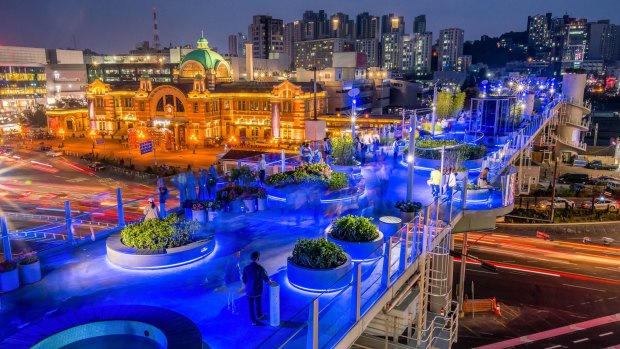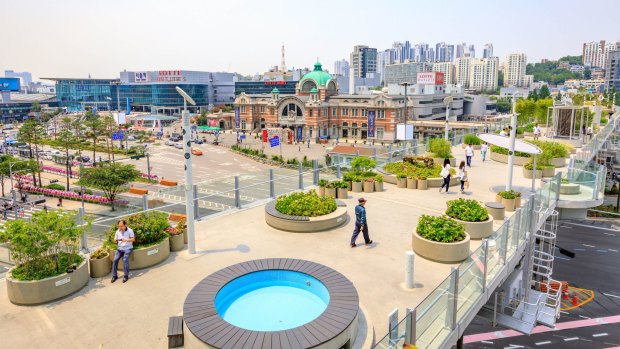This was published 5 years ago
Walking in Seoul on Seoullo 7017, the city's elevated walkway
Inspired by New York's High Line, Seoullo 7017 walkway offers a different view of Seoul.
By Libby Moffet

A night view of Seoul from the skypark.Credit: SHUTTERSTOCK
If I told you I'm walking along a gardened pathway stretching above a glittering metropolis of almost 10 million people, you may well think I'm on New York's famous High Line.
In fact, I'm more than 11,000 kilometres away, crossing the centre of Seoul on Seoullo 7017, the city's elevated walkway.
Stretching for more than a kilometre above some of the Seoul's oldest districts, Seoullo 7017 was opened in 2017 as part of a push to make the South Korean capital more pedestrian friendly and revitalise the neighbourhoods around Seoul Station in the city centre.

Seoullo 7017 was created from an old roadway.Credit: SHUTTERSTOCK
Created from an old roadway, the walkway offers a new perspective on Seoul, while its covering of more than 20,000 plants – from jasmine vines and rose bushes to magnolias and ginkgo trees – provides a green respite from the urban jungle below.
On the evening we visit, blue LED lights shine brightly from the hundreds of round concrete planters positioned along Seoullo 7017 in an effect designed to mimic the Milky Way, while around us the neon lights of the city dazzle like a disco ball.
Oblivious to passersby, a young girl is playing a classical refrain on one of about half a dozen colourfully painted pianos positioned along the path. Two men in suits stop by another keyboard, one dropping his briefcase to play a quick tune for his laughing mate before they resume their journey.
We are on a free night tour of Seoullo 7017 with a city guide, long-time Seoul resident Lee, who points out landmarks along the pathway as he explains how the city has grown and changed since its devastation during the civil war of 1950-53.
As he leads the way onto the walkway, Lee tells us that the 7017 in its name is drawn from the original roadway's creation in 1970 as well as its relaunch for pedestrians in 2017.
Seoullo (which means "road of Seoul" in Korean) 7017 also features the number 17 in other ways, with the pathway standing 17 metres above the ground and linking with 17 streets along its route.
Built to provide a fast connection between the districts on the east and west sides of the central station, the roadway carried traffic for more than 40 years until doubts were raised about its safety. It was earmarked for demolition until 2014 when the city decided to transform it to a sky garden, inspired by New York's High Line.
While the final result does not have the organic, natural vibe of the High Line, it is a strikingly different space for this bustling cosmopolitan capital, popular with locals and visitors.
As we begin our stroll with Lee, we are dwarfed by giant illuminated images of striding pedestrians projected onto a vivid media wall on the Seoul Square building beside us.
Between streets lined with twinkling office buildings we can see the striking N Seoul Tower on Namsan Mountain, the building's shaft glowing bright blue in the night sky, conveying a clever colour-coded message to residents that the city's air quality will be good tomorrow.
But while modernity surrounds us, the walkway also leads us to some of the city's key historical sites.
Above the old Seoul Station building, Lee points down at an impressive statue of a man clasping a grenade in his hand, a tribute to the Korean independence fighter who tried to assassinate the Japanese Governor-General in the plaza in 1919, during Japan's occupation of Korea.
Seoullo 7017's elevation also provides visitors with a dramatic view of the imposing Sungnyemun Gate, built in the 14th century as part of the city's impressive fortress wall and now listed as Korea's number one national treasure.
Amid the planters on the pathway, we are surprised to find a solo stall selling leather shoes and a range of locally-made garments. Lee explains that the shop is a nod to the shoemakers and clothing stores that were moved from the area to make way for the construction of the road in the '70s.
In a city that offers so many restaurants on the ground, there are remarkably few eateries on the walkway. To get a taste of the local offerings we decide to return on another day to join a new food tour specifically designed around Seoullo 7017, featuring restaurants in the Namdaemun neighbourhood as well as nearby Bukchangdong and Myeongdong.
Our journey starts at Seoul Station. After a short walk along Seoullo 7017, our guide, Veronica, leads us through the hectic laneways of Namdaemun markets. We follow her up some steep, narrow stairs covered with worn blue linoleum and find ourselves in a stark, bright restaurant featuring laminated tables and very little decoration.
Maknae Hoejib, which translates to "raw fish restaurant of the youngest of the family", is run by Kim Sunja, who, Veronica tells us, is famous for her fish. It is mid-afternoon when we visit and only a few tables are occupied but Veronica says it will be packed by 6pm.
I understand why when I taste Kim Sunja's sublime mackerel stew and sweet radishes. One should never judge a book by its cover, nor a restaurant by its stairs it seems.
We weave on through the market, as Veronica points out the various alleys, each featuring a particular food specialty such as tail fish, knife-cut noodles or oxtail, then leads us through back streets to traditional Korean restaurant Hangaram, where chef and owner Kim Bong-chan weaves his magic.
Clutching metal chopsticks, which are standard issue in Korean restaurants, we watch as colourful dishes of summer kimchi, hydrated radish, glass noodles, lotus roots, kimchi pancakes and short ribs appear before us.
Veronica is visibly excited as she describes Chef Kim's expertise in fermentation, his studies as a nutritionist and his strong belief in Korean cooking and home brewing, which was forbidden by the Japanese regime in the early 20th century.
We finish the meal with a delicious, sweet pumpkin punch, then head to the streets where Veronica continues to regale us with stories about her city and its food. Before we realise, we've walked through the heaving streets of Myeongdong and are seated in Sandong Gyoja, a small Chinese restaurant on the edge of the shopping precinct.
Here we taste two of the most popular Chinese meals in Korea, a sweet and sour pork dish and black bean noodles. Found in restaurants throughout the city for as little as 3000 to 5000 won (about $3.50-$6.50) a plate, black bean noodles are so popular that Korea even celebrates a Black Day each April 14, when singles who have not been part of Valentines Day activities gather to eat black bean noodles.
Veronica tells us that the noodles are so much of a dietary staple they are part of the basket of goods that the Korean Government uses to measure the inflation rate.
As the street lights start to glow and crowds swarm around the food hawker stands of Myeongdong, we slip into a shopping centre under the imposing Catholic cathedral for our final stop. We are full to the gills but Veronica assures us "it's time for something easy" – gelato.
Surveying the offerings at Essere Gelato we are quickly convinced we need more to eat. This specialty store is famous for wonderful concoctions featuring local ingredients and we are soon hoovering sublime scoops of nectarine, fig and rice-flavoured gelato.
As we finish the tour we agree there is only one sensible thing left to do. We get our bearings and head back to Seoullo 7017 to walk off our afternoon of eating.
TRIP NOTES
MORE
traveller.com.au/northeast-asia
VISIT
Seoullo 7017 is open 24 hours and is free to access. Free walking tours of the pathway can be booked online through visitseoul.net
EAT
Gastro Tour Seoul offers a range of food tours in Seoul. The Seoullo 7017: Namdaemun & Myeongdong Tasting Tour costs from US$80 and takes about three hours. See gastrotourseoul.com
FLY
Korean Air offers daily services to Seoul from Sydney and flies four to seven times a week from Brisbane depending on the season. See www.koreanair.com
Libby Moffet travelled at her own expense.
Sign up for the Traveller Deals newsletter
Get exclusive travel deals delivered straight to your inbox. Sign up now.